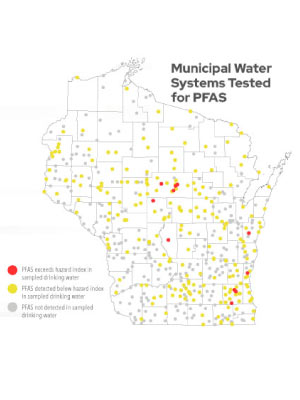 The Nelson Institute Issue Brief is a quarterly publication that summarizes and conveys up-to-date scholarship from across the UW–Madison campus on key issues of environmental concern. The latest edition focuses on PFAS, an acronym that refers collectively to perfluoroalkyl substances and polyfluoroalkyl substances.
The Nelson Institute Issue Brief is a quarterly publication that summarizes and conveys up-to-date scholarship from across the UW–Madison campus on key issues of environmental concern. The latest edition focuses on PFAS, an acronym that refers collectively to perfluoroalkyl substances and polyfluoroalkyl substances.
In recent years, PFAS have been detected in water bodies throughout Wisconsin, prompting statewide groundwater testing and calls for regulation. In 2022, the Wisconsin Department of Natural Resources set limits for PFAS concentrations in drinking water, and the EPA announced the first national standard for PFAS. However, much remains unknown about how they move through the environment and the health risks associated with exposure.
In this edition of the Nelson Issue Brief, learn about new methods for identifying PFAS sources and monitoring the extent of contamination in surface and groundwater to help resource managers protect the state’s valuable freshwater resources.
Featured in this issue:
- Nature and Fate of PFAS in Wisconsin Landfill Systems: James Tinjum
- Experiments and Modeling PFAS in Vulnerable Groundwater Systems: Nelson Institute affiliate Christopher Zahasky, William Gnesda, Elliot Draxler and James Tinjum
- Addressing PFAS in Wisconsin’s Municipal Wastewater Through Source Reduction: Nelson Institute Environment and Resources graduate student Jason Knutson and Nelson Institute affiliate Ken Genskow
- Understanding the Fate of PFAS in the Environment: Christina Remucal, Summer Sherman and Kaitlyn Gruber
Read the full Issue Brief or browse past editions.